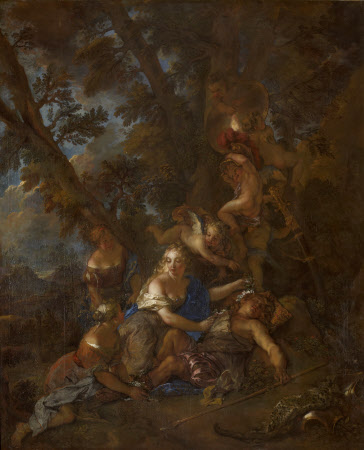Rinaldo and Armida
Charles de La Fosse (1636 - 1716)
Category
Art / Oil paintings
Date
1686 - 1687 - 1691
Materials
Oil on canvas
Measurements
1600 x 1350 mm
Place of origin
Paris
Order this imageCollection
Basildon Park, Berkshire
NT 266412
Caption
La Fosse painted two mythological pictures for Montagu House, London for the musicophile Ralph, the 1st Duke of Montagu, possibly whilst the artist was in England between 1686-87 and certainly by 1707 when they are listed in the Montagu inventory. The subject of one of the pair, now recognised as Rinaldo and Armida, was long thought to be Mars and Venus but its source is Tasso’s Jerusalem Delivered (1581) and was the inspiration of an opera by Philippe Quinault and Jean-Baptiste Lully which premiered in Paris in 1686. The subject of the other is the Rape of Europa. Although the subjects do not immediately relate, they are balanced by opposing triangular compositions and maidens with golden hair.
Summary
Oil painting on canvas, Rinaldo and Armida by Charles de la Fosse (1636-1716), circa 1688/87-1691. Rinaldo, a Christian Prince or crusading knight and Armida, a Saracen sorceress, are a pair of lovers from the Italian epic poem on the subject of the Crusades, Gerusalemme Liberata (Jerusalem Delivered) (1581) by Torquato Tasso (1544-1595). The subject here is Armida and the sleeping Rinaldo when, during his search for a magical island on the River Orontes in Syria, Rinaldo falls into an enchanted sleep. Armida discovers him, meaning to kill him, but falls in love with him instead. Rinaldo is seen lying underneath some trees with his head on a cushion, his armour and a leopard skin laid to one side. He holds a spear in his left hand. Armida, with long blonde hair and blue cloak, kneels beside him. She is accompanied by two female attendants, Phenice and Sidonie. Three putti fly above the head of Rinaldo, carrying off his helmet, shield and sword. A fourth points to Rinaldo. A landscape with distant hills can be seen at the far left. This painting forms one of a pair with NT 266411, The Rape of Europa, also by Charles de la Fosse.
Provenance
Painted for Ralph, 1st Duke of Montagu (1638-1708/9) for Montagu House, Bloomsbury, around 1688/87-1691, probably for staircase (in the 1709 inventory as 'In ye Great closet/ 2 great picture of Urope by Lafosse') and Montagu House Inventory 1735 no.20; presumably moved to Boughton House (Duke of Buccleuch) on the sale of Montagu House to the Trustees of the British Museum in 1754; Boughton House Inventory 1827 No.164 & Boughton House 1829 (copied 1910) in the Vestublum as no. 14, 'Mars and Venus; sold Sotheby's 20 July 1955, lot 49 as 'Mars and Venus'; bought Colnaghi and sold to Edward Langton Iliffe, 2nd Baron Iliffe of Yattendon (1908-1996); accepted in 1998 by HM Treasury in lieu of Inheritance Tax from the estate of Lord Iliffe
Credit line
Basildon Park, The Iliffe Collection (National Trust)
Makers and roles
Charles de La Fosse (1636 - 1716), artist
Exhibition history
Mythological works of Charles de la Fosse, Palace of Versailles, France, 2015 Mythological works of Charles de la Fosse, Musée des beaux-arts de Nantes, France , 2015
References
Hedley 2002 Jo Hedley, "Charles de la Fosse's 'Rinaldo and Armida' and Rape of Europa' at Basildon Park", The Burlington Magazine, vol. CXLIV, number 1189, April 2002, pp.204 - 212, illus. front cover Charles de La Fosse (1636-1716): Le Triomphe de la Couleur (ed. Beatrice Sarrazin, Adeline Collange-Perugi et Clémentine Gustin-Gomez), 24 February-24 May 2015, Versailles Palace and 19 June - 20 September 2015, Musée des Beaux-Arts, Nantes, pp.31, cat. 37a.

